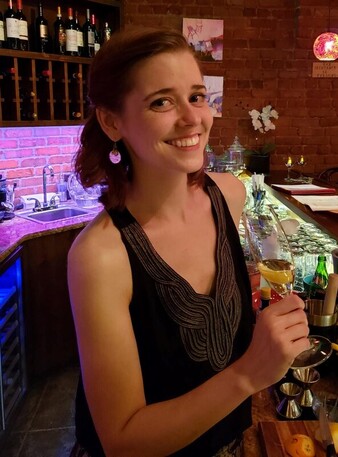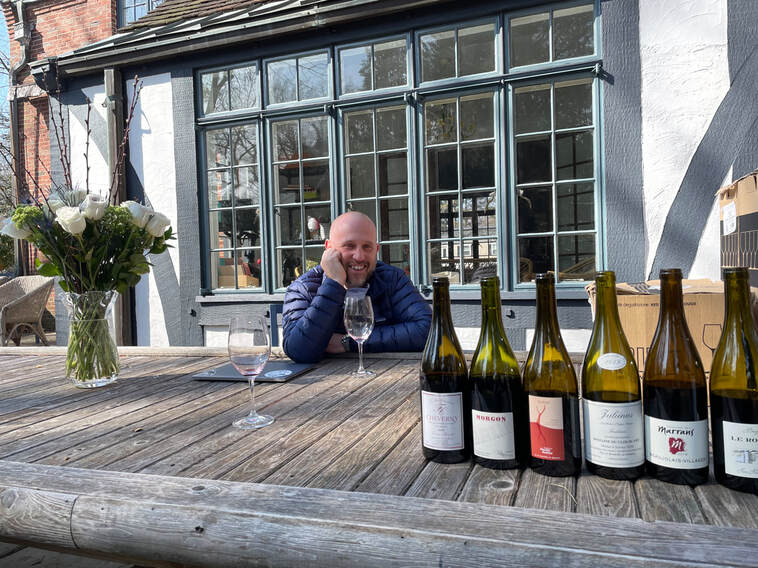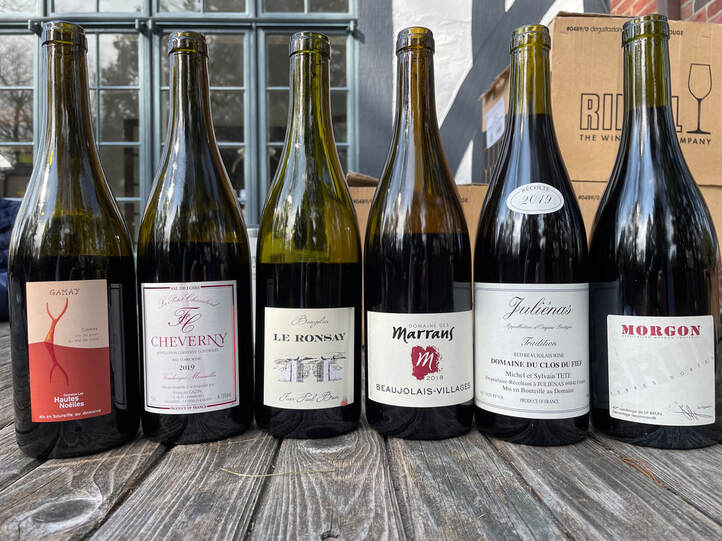|
It was a warm, bright, sunny, almost-Spring morning, and we were tasting Gamay in the backyard. What could be better? Nothing. But what exactly is Gamay? Well, to begin with it is the bastard child of Burgundy. Banished from the golden slopes in 1395 by Philip the Bold (and then again in 1459 by Philip the Good), so that to this day, Gamay is not to be found mingling with the illustrious Pinot of Bourgogne. Or sort of. Gamay is an old grape. In fact, it is a crossing of Pinot Noir and Gouais Blanc, which itself is a wild grape that has parentage to many of the wines we know today. The style of Gamay shares some characteristics with Pinot Noir – lots of delicate fruit, soft tannins and an ability to age when made by the right hands. But Gamay is not Pinot Noir. It is a little more on the wild side. It is a bit less finicky to grow and as such can be a good cropping grape, albeit with slightly less concentrated juice if allowed to grow too wild, which is why farmers like it but also why it was banned from Burgundy. Throughout central France, Gamay plays a role in many wine regions, but in general the best come from Beaujolais, as well as certain areas of the Loire. Many would agree that the granite slopes of the northern part of the Beaujolais district is where Gamay shines brightest; it loves the pink granite soils and the rolling hills of the area, which is France’s hilliest wine region, BTW. The Gamay here is pure, rich, and almost cult-like in a way. The farmers of the villages of Morgon and Fleurie and Moulin-a-Vent make some of the most dramatic wines – all from Gamay; be warned though, these are not your 1990s Nouveau. Here we find, even demand, serious, old vine, fruit driven but textural wines that are perfectly suited for food. Shift a little to the north and Gamay has a number of home appellations along the Loire (aka Le Jardin du France), where produces will often use it to blend with a few other grapes, most notably Pinot Noir. The variety of soils and cooler climates makes for more consistent wines year in and year out if your Pinot doesn’t quite ripen but your Gamay does. Plus – it just tastes good. Our tasting pack includes selections from each of these regions, and includes some of the region’s top producers. It was tough to limit ourselves to just six, but these are our favorites for the moment, and these will help you up your Gamay game, big time. A quick note on vintages: 2018, 2019 In a nut shell: Get in My Belly! These are spectacular vintages, period. Buy, drink, enjoy. Rinse your glasses and repeat. 2019 was a smaller cropped vintage, but the wines from across Europe are delicious, and the Gamay below are no exception. Bursting with fruit and concentration, the wines are fresh and beautiful. Do Not Miss Them. 2018 is a Cru year. These are drinking so well now, but the top Crus can be set aside for a few years and will shine as good as the best in Burgundy. Slightly lower alcohols, good acidity, and a concentrated purity that is rare. Wines Tasted
We split the wines up by region, but in the end did a quick ranking by preference and the wines ended up being mixed, which only proves that you can get great Gamay from both the Loire and the Beaujolais regions. Notes below are in the original tasting order, but please don’t ask us to reveal the final order – it can easily change if we did this tasting again. Domaine Les Hautes Noëlles Gamay Vin de Pays du Val de Loire, 2019 Super bright, just basically explodes with fruit on the palate. I called this the raspberry Starburst wine because it had so much lovely red fruit on the palate, backed by lush acidity that carried the flavors on an on. Young as can be, which is a good thing. 12%abv. François Cazin Cheverny Rouge Vendanges Manuelles, 2019 This is one of the BIG DOGS of the Loire, and this tasting. Right away you notice the color – it is beautifully saturated in the glass. The aromas are mellow but complex with an underlying intensity that pulls through the long finish, which include soft tannins that do not quit. This wine gets better after being open for a bit and was easily a favorite. 2/3 Pinot Noir, 1/3 Gamay. 13.8% abv Domaine Des Terres Dorées (Jean-Paul Brun) Beaujolais Le Ronsay, 2019 And the other Big Dog, Brun is an icon in the Beaujolais. This wine comes from younger vines in the southern part of the region, and is meant to showcase the fresh, youthful side of the grape. To me there was an abundance of raspberry and cinnamon, mixed with some tart cranberry and lush acidity. Fermented all in concrete and sees no oak (yes, that is a thing), it has beautiful texture through the finish. Lovely wine for any night of the week. 13% abv Domaine du Clos du Fief (Michel & Sylvian Tete) Juliénas, 2019 This wine has great fruit on the nose, and is perhaps the most well-balanced wine of the group. Dusty tannins, smooth in texture and the red fruit just goes on and on. A very lifted style of wine with complexity. 14.5% abv Domaine des Marrans Beaujolais-Villages, 2018 This is a family estate located in Fleurie, with holdings essentially only in Crus. This is actually older vines from those Crus, and the wine shows its pristine pedigree wonderfully. Round, juicy, super smooth and very complex for a “simple” Beaujolais-Villages. Don’t get fooled – you are drinking The Villages in this wine. 13% abv Domaine Des Terres Dorées (Jean-Paul Brun) Morgon, 2018 BOOM. Brun. (Mic drop, please.) Here you go. And then some. Wonderful wine. The essence of what Cru Beaujolais is meant to be; what it can be; why Burgundy should be shaking in their muddy-boots. Brings everything together: huge nose, super polished style, loads of fruit on the palate, super well integrated tannins. Blackberry leaf, plum, bramble, savory, earthy – just get some. (I read a review for this wine that recommended it is best from 2023-2055+. What will you be doing in 2055? Drinking Beaujolais, baby!)
0 Comments
Associate Educator Added to New England Wine Academy as well as WSET Hybrid Learning Sessions1/21/2021  New England Wine Academy is very pleased to announce a new partnership with Julia Menn, as an associate educator. Julia will be guiding students through Levels 1 and 2 Wine Awards, with class set-up and delivered as hybrid sessions. What is a Hybrid session? Glad you asked... Hybrid sessions are classes that are offered with the delivery being done online via a webinar format. The real difference here is that during the class sessions you will have facetime with a real instructor. The WSET Online model is a great format, but the only small drawback is that you are not in a live session with an instructor. And while the instructors are great at getting back to students with answers to questions, and tasting note feedback, there is really nothing like having a person answer your questions and give you all the information needed, right then and there. Julia has earned her Level 3 in Wine, works in the wine industry, and even teaches classes on her own. You can read her bio by clicking here. We are pleased to offer two WSET wine levels, initially, starting in February and March, with Julia as your guide and instructor. Click on the buttons below for full details, and do not be afraid to ask us questions. Cheers
My brother Adam and I got into a conversation about a wine he was drinking, why he bought it, and was it something I would ever buy. Plus we discuss a little about the appellation system in the US and a few other things. Don't mind his Ali G outfit - he drops it shortly in the video.
His wine was the Cooper & Thief Pinot Noir (California) My wine was Marques de Casa Concha Cabernet Sauvignon (Chile) |
ABOUT THE Author
Brian Mitchell runs The New England Wine Academy, and is responsible for the content of this blog. With 30 years of drinks industry experience, Brian has learned a few things, but everyday he is learning more. This blog helps to bring that knowledge to you. Archives
July 2024
Categories
All
|
Copyright 2018 > 2024 by New England Wine Academy, LLC
we advocate making responsible decisions
we advocate making responsible decisions



 RSS Feed
RSS Feed
